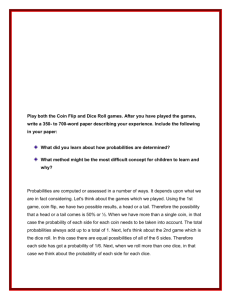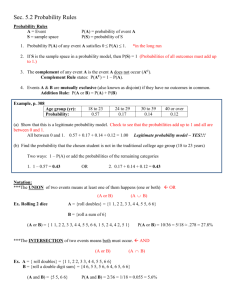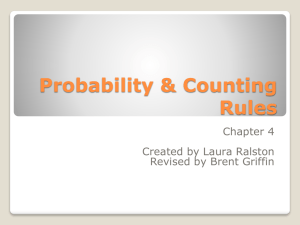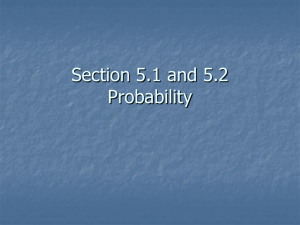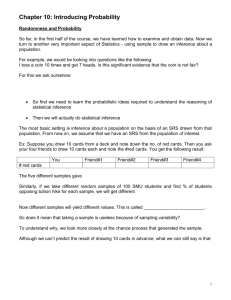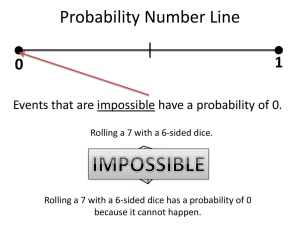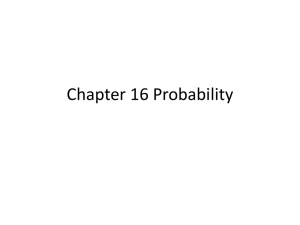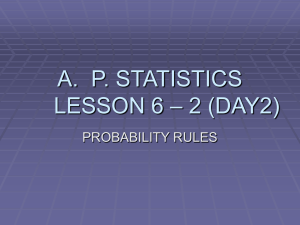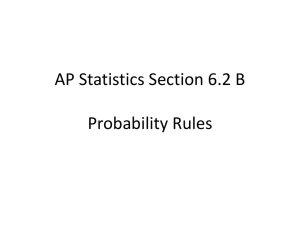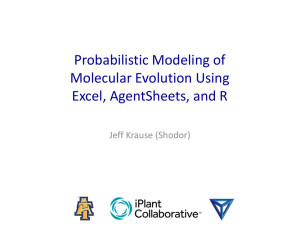Chapter9
advertisement
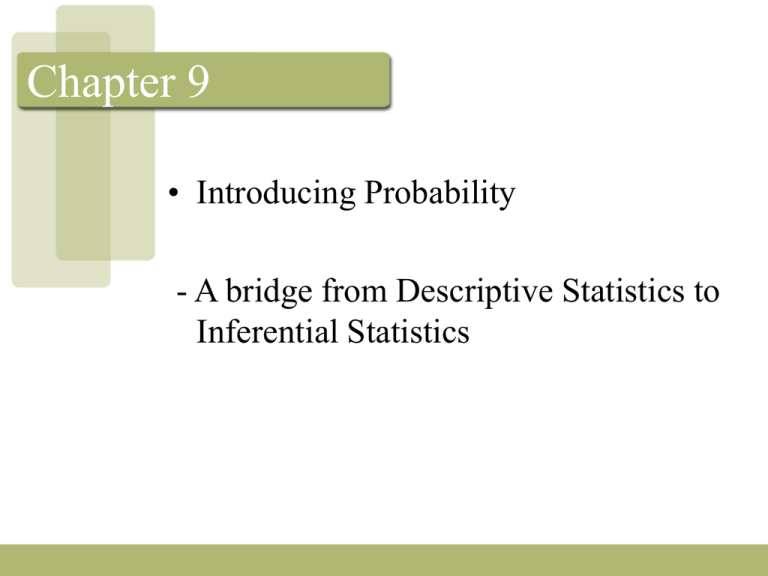
Chapter 9
• Introducing Probability
- A bridge from Descriptive Statistics to
Inferential Statistics
Chapter outline
•
•
•
•
The idea of probability
Thinking about the randomness
Probability models
Assigning probabilities: finite number of
outcomes
• Assigning probabilities: intervals of
outcomes
• Normal probability models
• Random variables
The idea of probability
• Some event where the outcomes is
uncertain. Examples of such outcomes
would be the roll of a die, the amount of
rain that we get tomorrow, or who will
be the president of the United Sates in
the year 2004.
• In each case, we don’t know for sure
what will happen. For example, when we
toss a coin once, we don’t know exactly
what we will get (Head or Tail).
The idea of probability
• Probability theory allows us to make some
sense out of happening due to chance.
• Example: If you flip a coin many times, about half
the time you get heads and the other half you get
tails. In general, the more times you flip the coin,
the closer the ratio of heads to tails comes to one.
• Question: Why should this always be so?
• Answer: There is a mathematical rule governing
coin flipping – it says that when you flip a coin, the
outcomes are about even between heads and tails.
Thinking about randomness
• A phenomenon is random if each outcome is
uncertain but there is nonetheless a regular
distribution of outcomes in a large number of
repetitions.
– Examples of random phenomena
• The probability of any outcomes of a random
phenomenon is the proportion of times the
outcome would occur in a very long series of
repetitions.
Definitions
• Sample space: the set of all possible
outcomes. We denote S
• Event: an outcome or a set of outcomes
of a random phenomenon. An event is a
subset of the sample space.
• Probability is the proportion of success
of an event.
• Probability model: a mathematical
description of a random phenomenon
consisting of two parts: S and a way of
assigning probabilities to events.
Example 9.6 (P.232)
• We roll two dice and record the upfaces in order (first die, second die)
– What is the sample space S?
– What is the event A: “ roll a 5”?
Probability models
• Example 9.6 (p.232): Rolling two dice
– We roll two dice and record the up-faces in order
(first die, second die)
– All possible outcomes
•
•
•
•
•
•
(1,1) (1,2) (1,3) (1,4) (1,5) (1,6)
(2,1) (2,2) (2,3) (2,4) (2,5) (2,6)
(3,1) (3,2) (3,3) (3,4) (3,5) (3,6)
(4,1) (4,2) (4,3) (4,4) (4,5) (4,6)
(5,1) (5,2) (5,3) (5,4) (5,5) (5,6)
(6,1) (6,2) (6,3) (6,4) (6,5) (6,6)
– “Roll a 5” : {(1,4) (2,3) (3,2) (4,1)}
Example 9.4 (P.229)
• We roll two dice and count the spots on
the up-faces.
– What is the sample space S?
– What is the event B: “ I get an even
number.”?
– What is the event C: “ I get an odd
number.” ?
– What is the event D: “ I get a count less
than 4”?
Probability rules
• Rule 1: For any event E, 0<=P(E)<=1.
• Rule 2: If S is the sample space in a probability
model, then P(S)=1.
• Rule 3: For any event E, P(E does not occur)
= 1-P(E occurs)
• Rule 4: For two disjoint (mutually exclusive)
events E and F, P(E or F) = P(E) +P(F)
• In a probability experiment, two events E and F are said to
be disjoint if they cannot both occur simultaneously.
For example : we throw a die once. Let’s say the event E an
even number is thrown and F an odd number is thrown.
• Question: Are E and F disjoint?
Assigning probabilities:
• Case I: finite number of outcomes
– Assign a probability to each individual
outcome.
– These probabilities must be numbers
between 0 and 1 and must have sum 1.
– Probability histogram is useful.
Example 9.7 (P.233)
• S={1,2,3,4,5,6,7,8,9}
• Let X=first digit.
• Probability model:
– X
– P
1
2 3 4
5
6
7 8 9
1/9 1/9 1/9 1/9 1/9 1/9 1/9 1/9 1/9
• P(X>=6)=?
• P(X>6)=?
• P(5<X<9)=?
Assigning probabilities:
• Case II: intervals of outcomes
• Example: P(0.3<=Y<=0.7) =?
– Y = a random number between 0 and 1
– S={all numbers between 0 and 1} = [0,1]
• Idea: area under a density curve.
• Example 9.8 (page 235)
• Exercise 9.9 (page 237)
Random variables
• Random variable: a variable whose
value is a numerical outcome of a random
phenomenon. There are two kinds of
random variables corresponding to the
ways of assigning probabilities.
– Discrete random variable: spread on the
number line discretely.
– Continuous random variable: interval
Probability distributions
• Probability distribution of a random
variable X: it tells what values X can take and
how to assign probabilities to those values.
– Probability of discrete random variable: list of
the possible value of X and their probabilities
– Probability of continuous random variable:
density curve.
Random variables
• Example: tossing a coin 4 times
– S={HHHH, HHHT,HHTH,…,TTTT}, It has
16 possible outcomes.
– Suppose that we are interested in number of
heads, then S={0,1,2,3,4}
– We can assign probabilities to each
outcome.
• Example: Uniform distribution over
[0,1]
– S=(0,1)
– We can assign probabilities over interval

